Top Rankings
University City School District ranks among the top 20% of public school district in Missouri for:
Category
Attribute
Diversity
Most diverse schools (Top 1%)
Community Size
Largest student body (number of students) (Top 1%)
For the 2025 school year, there is 1 public middle school serving 550 students in University City School District. This district's average middle testing ranking is 1/10, which is in the bottom 50% of public middle schools in Missouri.
Public Middle School in University City School District have an average math proficiency score of 19% (versus the Missouri public middle school average of 38%), and reading proficiency score of 22% (versus the 40% statewide average).
Minority enrollment is 90% of the student body (majority Black), which is more than the Missouri public middle school average of 31% (majority Black).
Overview
This School District
This State (MO)
# Schools
7 Schools
830 Schools
# Students
2,672 Students
233,376 Students
# Teachers
229 Teachers
20,291 Teachers
Student : Teacher Ratio
12:1
12:1
District Rank
University City School District, which is ranked within the bottom 50% of all 553 school districts in Missouri (based off of combined math and reading proficiency testing data) for the 2021-2022 school year.
The school district's graduation rate of 75-79% has decreased from 87% over five school years.
Overall District Rank
#493 out of 557 school districts
(Bottom 50%)
(Bottom 50%)
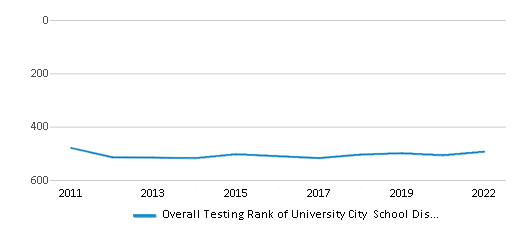
Math Test Scores (% Proficient)
21%
39%
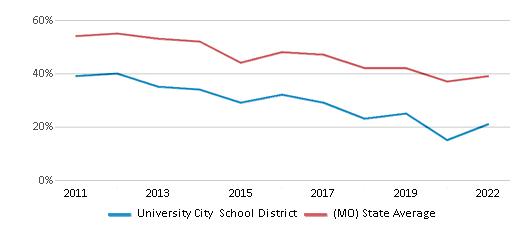
Reading/Language Arts Test Scores (% Proficient)
27%
43%

Science Test Scores (% Proficient)
20%
38%

Graduation Rate
75-79%
90%
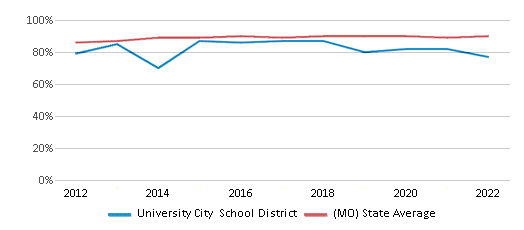
Students by Ethnicity:
Diversity Score
0.43
0.49
# American Indian Students
6 Students
895 Students
% American Indian Students
n/a
1%
# Asian Students
24 Students
4,582 Students
% Asian Students
1%
2%
# Hispanic Students
208 Students
18,531 Students
% Hispanic Students
8%
8%
# Black Students
1,984 Students
35,869 Students
% Black Students
74%
15%
# White Students
306 Students
161,241 Students
% White Students
12%
69%
# Hawaiian Students
n/a
840 Students
% Hawaiian Students
n/a
n/a
# Two or more races Students
144 Students
11,418 Students
% of Two or more races Students
5%
5%
Students by Grade:
# Students in PK Grade:
113
2,573
# Students in K Grade:
209
2,732
# Students in 1st Grade:
217
2,984
# Students in 2nd Grade:
198
2,965
# Students in 3rd Grade:
225
3,038
# Students in 4th Grade:
180
3,162
# Students in 5th Grade:
169
6,674
# Students in 6th Grade:
203
47,831
# Students in 7th Grade:
172
65,734
# Students in 8th Grade:
175
66,934
# Students in 9th Grade:
208
7,517
# Students in 10th Grade:
204
7,274
# Students in 11th Grade:
213
7,118
# Students in 12th Grade:
186
6,840
# Ungraded Students:
-
-
District Revenue and Spending
The revenue/student of $23,240 is higher than the state median of $15,081. The school district revenue/student has stayed relatively flat over four school years.
The school district's spending/student of $17,732 is higher than the state median of $13,908. The school district spending/student has stayed relatively flat over four school years.
Total Revenue
$62 MM
$13,447 MM
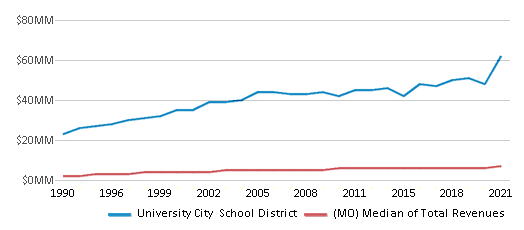
Spending
$47 MM
$12,401 MM

Revenue / Student
$23,240
$15,081

Spending / Student
$17,732
$13,908
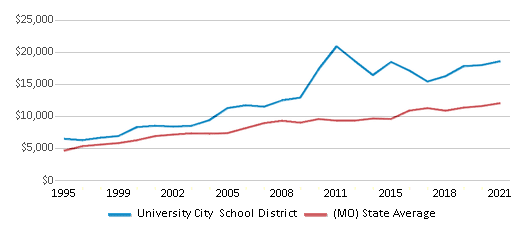
Best University City School District Public Middle Schools (2025)
School
(Math and Reading Proficiency)
(Math and Reading Proficiency)
Location
Grades
Students
Rank: #11.
Brittany Woods
(Math: 19% | Reading: 22%)
Rank:
Rank:
2/
Bottom 50%10
8125 Groby Rd
Saint Louis, MO 63130
(314) 290-4280
Saint Louis, MO 63130
(314) 290-4280
Grades: 6-8
| 550 students
Recent Articles

Year-Round Or Traditional Schedule?
Which is more appropriate for your child? A year-round attendance schedule or traditional schedule? We look at the pros and cons.

Why You Should Encourage Your Child to Join a Sports Team
Participating in team sports has a great many benefits for children, there is no doubt. In this article you will learn what those benefits are.

White Students are Now the Minority in U.S. Public Schools
Increasing birth rates among immigrant families from Asia and Central and South America, combined with lower birth rates among white families, means that for the first time in history, public school students in the United States are majority-minority. This shift in demographics poses difficulties for schools as they work to accommodate children of varying language abilities and socio-economic backgrounds.





